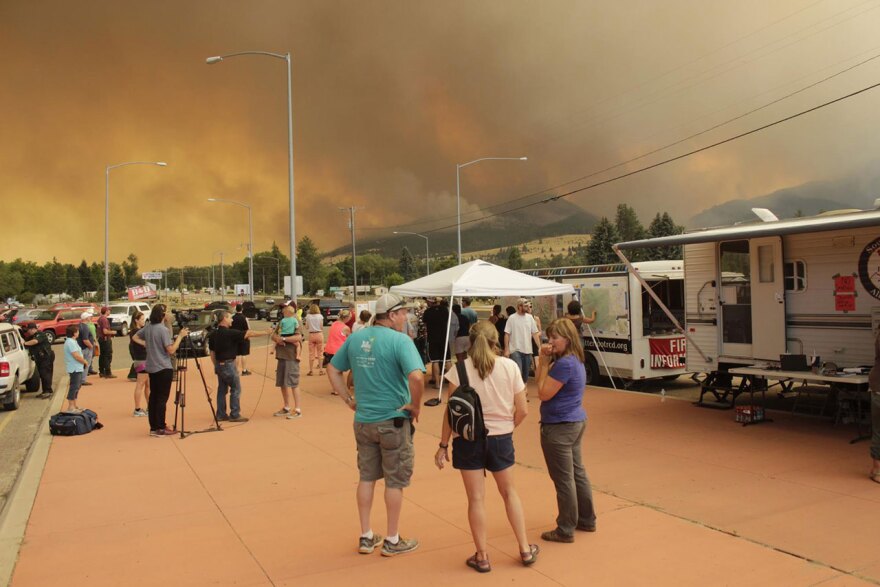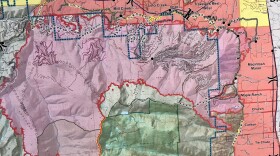Forecasters are predicting a couple more relatively calm days on the Lolo Peak Fire southwest of Missoula. This after firefighters and communities from Lolo south to Florence faced their most severe test when the fire grew explosively Friday night, eating up 9,000 acres in a single day.
We’ll have more on what firefighters are expecting in a moment, but for now, let’s go back to Friday night when MTPR’s Beau Baker was reporting from the junction of Highways 12 and 93.
When I arrived in Lolo Friday afternoon, the incident command post at the Highway 12 junction was buzzing with activity.
Crowds of people gathered around maps to get the latest news on the Lolo Peak Fire from several fire information officers. One of them was Mike Martin.
"This fire has tremendous potential and today we're under red flag warnings for strong westerly winds, but right now we're engaging the fire, and we're trying to limit the growth and suppress it where we can."
According to Martin, hundreds of residents had been stopping by hourly throughout the day. The scene here was tense. Everyone was bracing for winds that were forecast to hit in a few hours. I spoke with a few residents to find out why they were here.
Kim Erickson had been evacuated.
"It really became clear what was important," Erickson says. "I don't care about anything. I want my husband, I want my dogs and I want to be safe, and that was it."
Another evacuee, Kathy Clark, said her husband had stayed behind to protect their home.
"He does not want to go, because if a spark falls, it could start a fire that could burn our home, but if he's there to put it out, maybe he can save our place if it gets that far, I don't know."
At 5:40 p.m., a caravan of emergency vehicles turned down Highway 12. Bill Queen, another fire information officer, told me reinforcements were being dispatched to the Mill Creek area to deal with a 50-acre spot fire.
"It's still within our primary control line, but it's a concern because there are a lot of homes adjacent to where this is at," Queen says.
Just minutes after speaking with Queen, Highway 12 was closed.
The sky was now an unearthly red. Huge flames were visible in the timber on Mormon Peak. Fire activity was ramping up on multiple fronts.
By 6:20, a new evacuation order was in place. A dozen law enforcement officials set out to alert residents.

Again, fire information officer Mike Martin.
"The fire is approximately 1.5 miles from Highway 12 at its closest point. It has not crossed Highway 12."
For the next four hours, the fire raged, and this roadside stop was inundated with onlookers. As night came, the view of the blaze was apocalyptic.
Fortunately, by 11 p.m. the winds were calming and the wall of flames charging toward town had settled. Crews were emerging from the front, signaling a stop in activity for now.
The red flag warning that Friday’s dry cold front brought with it lasted through Saturday. But Fire Information Officer Mike Cole said conditions actually ended up being very favorable for firefighting on Saturday.
"That’s probably the best day we’ve had since we’ve been here, as far as not having to be running all day long having to keep up with where this fire was moving to."
Cole said crews were able to do burn-outs pretty much all day long on Saturday in both the Highway 12 and 93 corridors. Those have been the key strategy in recent days in keeping the fire from pushing past bulldozed containment lines at the foot of mountains, and away from homes and the highways in the valley bottoms, "to make sure we had a large black area before that fire front came moving toward the lines." Cole says.
The idea with the burnout operations is, you burn those areas on your terms, and that prevents the fire from getting there on its own and burning more intensely and more out of control.
"Absolutely correct," says Cole. "The problem is, if we would have not done any of those burnout operations, when that fire came down the hill, we would have had a 12-foot ‘dozer line or a road, as opposed to having maybe a mile of black in front of that fire. So, as soon as those big runs with the fire, especially the one that came down through Highway 12, if we would not have had done any burnout operations, this would a whole different picture now than it has become, because we’d be at the mercy of where that fire went out through those residential areas."
On Sunday night fire managers explained their strategy at a public meeting at the Baptist Church in Florence. They got applause for their work, which apparently is making it possible to lift evacuation orders in a couple of areas where homes were very close to being lost Friday night west of Lolo.
Fire behavior analyst Stewart Turner had more good news: Sunday’s calm fire weather is expected to continue through Monday and Tuesday. But, he said, "Wednesday, however, we’re in for another change. Wednesday is going to be another big fire weather day … bringing a little bit more wind in, lower humidities and the fire behavior is going to pick up significantly around the fire."
Turner said the forecast calls for the more dangerous weather pattern to break down on Thursday and Friday, but, he cautioned, Friday is a pretty long way out to be predicting weather accurately. He and other public safety officials warned the public not to get complacent by a few days of relative calm on the Lolo Peak Fire, which is expected to remain dangerous into the foreseeable future.










